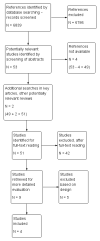Public release of performance data in changing the behaviour of healthcare consumers, professionals or organisations
- PMID: 22071813
- PMCID: PMC4204393
- DOI: 10.1002/14651858.CD004538.pub2
Public release of performance data in changing the behaviour of healthcare consumers, professionals or organisations
Update in
-
Impact of public release of performance data on the behaviour of healthcare consumers and providers.Cochrane Database Syst Rev. 2018 Sep 6;9(9):CD004538. doi: 10.1002/14651858.CD004538.pub3. Cochrane Database Syst Rev. 2018. PMID: 30188566 Free PMC article.
Abstract
Background: It is becoming increasingly common to release information about the performance of hospitals, health professionals or providers, and healthcare organisations into the public domain. However, we do not know how this information is used and to what extent such reporting leads to quality improvement by changing the behaviour of healthcare consumers, providers and purchasers, or to what extent the performance of professionals and providers can be affected.
Objectives: To determine the effectiveness of the public release of performance data in changing the behaviour of healthcare consumers, professionals and organisations.
Search methods: We searched the Cochrane Central Register of Controlled Trials (CENTRAL), Cochrane Effective Practice and Organisation of Care (EPOC) Trials Register, MEDLINE Ovid (from 1966), EMBASE Ovid (from 1979), CINAHL, PsycINFO Ovid (from 1806) and DARE up to 2011.
Selection criteria: We searched for randomised or quasi-randomised trials, interrupted time series and controlled before-after studies of the effects of publicly releasing data regarding any aspect of the performance of healthcare organisations or individuals. The papers had to report at least one main outcome related to selecting or changing care. Other outcome measures were awareness, attitude, views and knowledge of performance data and costs.
Data collection and analysis: Two review authors independently screened studies for eligibility and extracted data. For each study, we extracted data about the target groups (healthcare consumers, healthcare providers and healthcare purchasers), performance data, main outcomes (choice of healthcare provider and improvement by means of changes in care) and other outcomes (awareness, attitude, views, knowledge of performance data and costs).
Main results: We included four studies containing more than 35,000 consumers, and 1560 hospitals. Three studies were conducted in the USA and examined consumer behaviour after the public release of performance data. Two studies found no effect of Consumer Assessment of Healthcare Providers and Systems information on health plan choice in a Medicaid population. One interrupted time series study found a small positive effect of the publishing of data on patient volumes for coronary bypass surgery and low-complication outliers for lumbar discectomy, but these effects did not persist longer than two months after each public release. No effects on patient volumes for acute myocardial infarction were found.One cluster-randomised controlled trial, conducted in Canada, studied improvement changes in care after the public release of performance data for patients with acute myocardial infarction and congestive heart failure. No effects for the composite process-of-care indicators for either condition were found, but there were some improvements in the individual process-of-care indicators. There was an effect on the mortality rates for acute myocardial infarction. More quality improvement activities were initiated in response to the publicly-released report cards. No secondary outcomes were reported.
Authors' conclusions: The small body of evidence available provides no consistent evidence that the public release of performance data changes consumer behaviour or improves care. Evidence that the public release of performance data may have an impact on the behaviour of healthcare professionals or organisations is lacking.
References
References to studies included in this review
-
-
*
- Farley DO, Elliott MN, Short PF, Damiano P, Kanouse DE, Hays RD. Effect of CAPHS Performance Information on health plan choices by Iowa Medicaid. Medical Care Research and Review. 2002;59(3):319–36. - PubMed
-
-
-
*
- Romano PS, Hong Zhou MPH. Do well-publicized risk-adjusted outcomes reports affect hospital volume? Medical Care. 2004;42(4):367–77. - PubMed
-
-
- Tu JV, Donovan LR, Douglas SL, Wang JT, Austin PC, Alter DA, et al. Effectiveness of public report cards for improving the quality of cardiac care. The EFFECT study: a randomized trial. JAMA. 2009;302(21):2330–7. - PubMed
References to studies excluded from this review
-
- Alterras TT. Health plan report cards may influence insurers more than consumers: their effect on insurer behavior in Minnesota. Health Care Financing and Organization. 2000;3(3):1–2. - PubMed
-
- Beaulieu ND, Epstein AM. National Committee on Quality Assurance health-plan accreditation: predictors, correlates of performance, and market impact. Medical Care. 2002;40(4):325–87. - PubMed
-
- Beaulieu ND. Quality information and consumer health plan choices. Journal of Health Economics. 2002;21(1):43–63. - PubMed
-
- Bundorf MK, Chun N, Goda GS, Kessler DP. Do markets respond to quality information? The case of fertility clinics. Journal of Health Economics. 2009;28(3):718–27. - PubMed
-
- Dawson D, Gravelle H, Jacobs R, Martin S, Smith PC. The effects of expanding patient choice of provider on waiting times: evidence from a policy experiment. Health Economics. 2007;16(2):113–28. - PubMed
Additional references
-
- Bentley JM, Nash DB. How Pennsylvania hospitals have responded to publicly released reports on coronary artery bypass graft surgery? The Joint Commission Journal on Quality Improvement. 1998;24(1):40–9. - PubMed
-
- Berwick DM, Wald DL. Hospital leaders’ opinions of the HCFA mortality data. JAMA. 1990;263(2):247–9. - PubMed
-
- Berwick D, Jamer B, Coye M. Connections between quality measurements and improvement. Medical Care. 2003;41(1):130–8. - PubMed
-
- Brook RH. Health care reform is on the way: do we want to compete on quality? Annals of Internal Medicine. 1994;120(1):84–6. - PubMed
Publication types
MeSH terms
LinkOut - more resources
Full Text Sources
Medical


